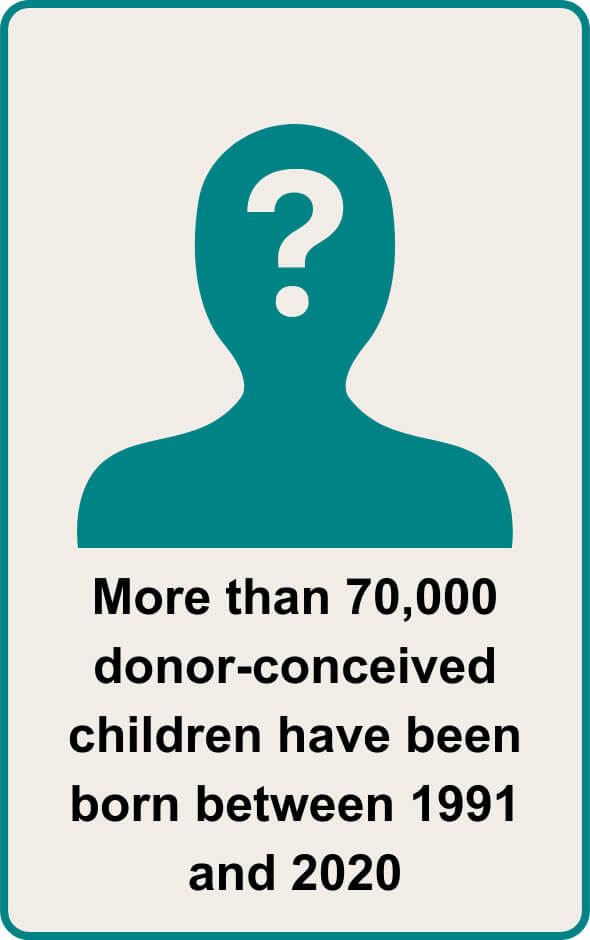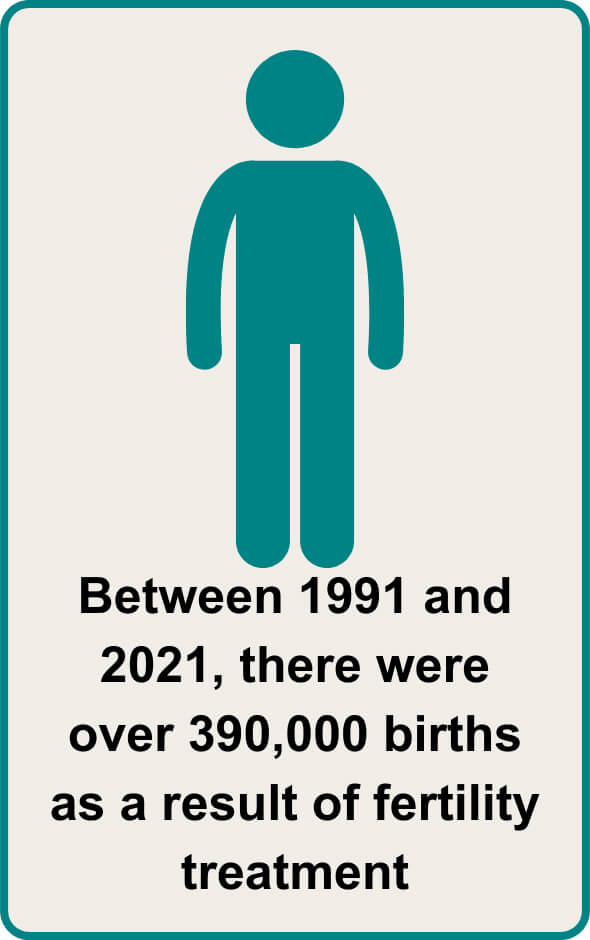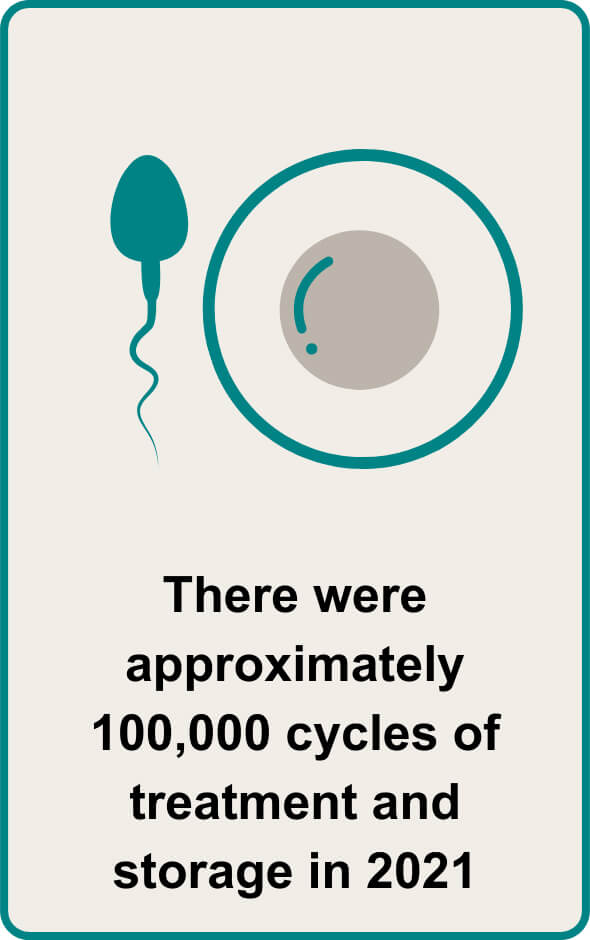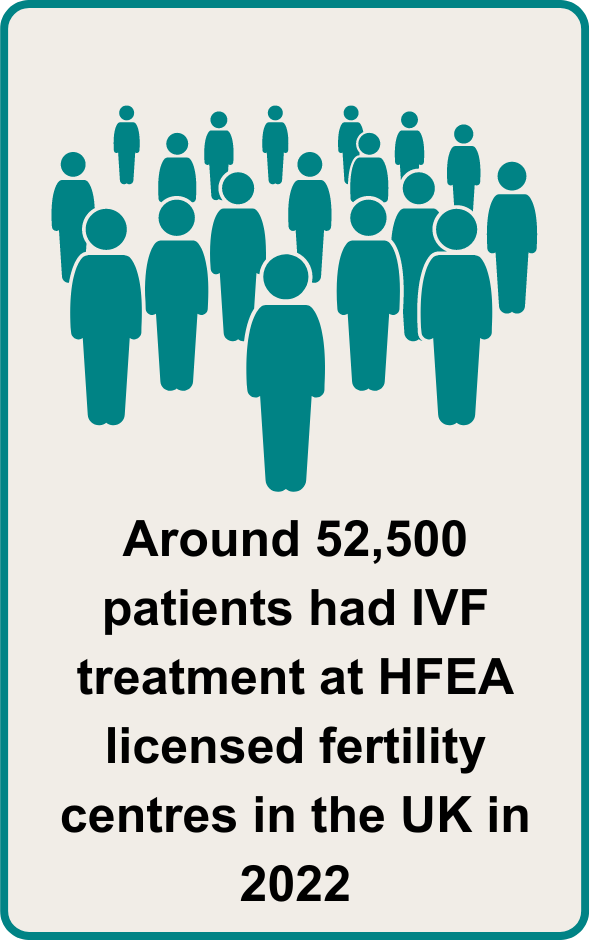 Our award-winning dashboard gives users the opportunity to explore HFEA data and find statistics on their own areas of interest. Find out more here.
Our award-winning dashboard gives users the opportunity to explore HFEA data and find statistics on their own areas of interest. Find out more here.IVF
Data from: Fertility treatment 2022: preliminary trends and figures
- Around 52,500 patients had in vitro fertilisation (IVF) and 3,000 had donor insemination (DI) treatment, at Human Fertilisation and Embryology Authority (HFEA) licensed fertility centres in the UK in 2022.
- IVF cycles (fresh and frozen embryo transfers) increased to 77,000 cycles in 2022 from around 69,000 in 2019 (+11%). DI cycles returned to pre-pandemic numbers of around 6,000 cycles (-1%) in 2022.
- Average IVF pregnancy rates using fresh embryo transfers increased nationally to 31% per fresh embryo transferred in 2022, with the highest pregnancy rates among patients aged 18-34 at 42%.
- The average age of first-time IVF patients increased to just over 35 years old and DI patients’ average age was 33.6 in 2022. In comparison, the overall average age that women in England and Wales had their first birth in 2022 was 29.2, according to the Office for National Statistics (ONS).
- The number of NHS-funded IVF cycles carried out continued to vary across the UK with decreases of 17% in England, 16% in Wales, and 7% in Scotland from 2019 to 2022.
- NHS funding for IVF cycles varies considerably across the UK depending on national funding criteria and local funding across Integrated Care Boards (ICBs) in England. In 2022, NHS-funded IVF cycles decreased to 27% across the UK, falling from 40% in 2012.
- One cycle of IVF can take 3 to 6 weeks. (In vitro fertilisation (IVF))
Egg freezing
Data from: Fertility treatment 2022: preliminary trends and figures
- Egg storage cycles accounted for 5% of cycles across the UK in 2022.
- Egg and embryo storage cycles are the fastest growing fertility treatments in the UK. Egg storage cycles increased from 2,571 in 2019 to 4,647 in 2022 (+81%), while embryo storage cycles increased from 8,251 in 2019 to 9,311 in 2022 (+13%).
- Due to how the data is stored on our Register, we cannot provide accurate success rates for frozen egg cycles. This is because we cannot reliably link the age of the patient at egg freezing, which will have the greatest impact on success rates in egg thaw cycles, with when they had treatment. For these reasons, we recommend looking at the success rate for fresh IVF cycles with patients using their own eggs, even when considering egg/embryo freezing or thawing.
Donation
Data from: Trends in egg, sperm and embryo donation 2020
- Donor conception led to more than 4,100 births in 2019, accounting for 1 in 170 of all births and for nearly 1 in 6 births using IVF in the UK.
- The number of children born from donor sperm more than tripled from under 900 in 2006, to over 2,800 in 2019. This increase was driven by single patients, and patients in female same-sex relationships.
- More than 70,000 donor-conceived children have been born since 1991.
- Around 1 in 6 children born as a result of IVF treatment were conceived using donor eggs, sperm or embryos in 2019.
- The number of donor-conceived people in the UK newly eligible to request identifying information about their donor will rise from around 70 in 2022 to a maximum of almost 1,300 in 2024.
- By 2030, we predict there will be an average of one or two donor conceived children in every English state primary school. (Fresh plea from UK fertility regulator as monumental changes to donor anonymity law finally come to fruition)
- New egg and sperm donors increased by 21% from 2019 to 2022, however UK-based sperm donors decreased by 11%. (Fertility treatment 2022: preliminary trends and figures)
- New egg donors increased by 19% from 1,495 in 2019 to 1,782 in 2022, while sperm donors increased by 23% from 841 to 1,037.
(Fertility treatment 2022: preliminary trends and figures)
About the HFEA
- The HFEA is the UK’s independent regulator of fertility treatment and research using human embryos.
- Set up in 1990 by the Human Fertilisation and Embryology Act, the HFEA is responsible for licensing, monitoring, and inspecting fertility clinics - and taking enforcement action where necessary - to ensure everyone accessing fertility treatment receives high quality care.
- The HFEA is an ‘arm’s length body’ of the Department for Health and Social Care, working independently from Government providing free, clear, and impartial information about fertility treatment, clinics and egg, sperm and embryo donation.
- The HFEA collects and verifies data on all treatments that take place in UK licensed clinics which can support scientific developments and research and service planning and delivery.
- The HFEA holds records of all fertility treatments and outcomes taking place in licensed clinics since 1991.
- The HFEA is funded by licence fees, IVF treatment fees and a grant from UK central government. For more information visit, hfea.gov.uk
Review date: 18 July 2026






